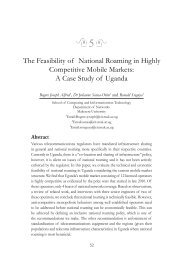Undergraduate Handbook - School of Computing and Informatics ...
Undergraduate Handbook - School of Computing and Informatics ...
Undergraduate Handbook - School of Computing and Informatics ...
You also want an ePaper? Increase the reach of your titles
YUMPU automatically turns print PDFs into web optimized ePapers that Google loves.
contracting <strong>and</strong> maintenance; Security in computing: continuity <strong>of</strong> processes, controls <strong>and</strong> planning for st<strong>and</strong>by;<br />
Computer audit; Project management: approaches, tools, site planning <strong>and</strong> installation.<br />
Reference Books:<br />
i. G. Curtis, Business Information Systems: Analysis, Design <strong>and</strong> Practice, 1995.<br />
ii. P. Bocij, D. Chaffey, A. Greasley, <strong>and</strong> S. Hickie, Business Information Systems: Technology,<br />
Development <strong>and</strong> Management for the E-Business, 2005.<br />
BIS 1201: Distributed Information Systems (4 CU)<br />
Course Description: Upon completion <strong>of</strong> this course, the student will: Underst<strong>and</strong> the basic principles underlying<br />
distributed information systems in general <strong>and</strong> client-server model (which is viewed as a specialization <strong>of</strong> distributed<br />
information systems) in particular. Underst<strong>and</strong> the characteristics <strong>of</strong> common architectures <strong>and</strong> technical issues for<br />
distributed <strong>and</strong> client-server information systems. Have the knowledge <strong>and</strong> skills to design, plan, implement <strong>and</strong><br />
support distributed information systems, services <strong>and</strong> server components.<br />
Indicative Content: This course will cover: a broad foundation in distributed <strong>and</strong> client-server information systems<br />
from both a managerial <strong>and</strong> a systems development point <strong>of</strong> view; provide a base from which the student can<br />
assimilate knowledge <strong>of</strong> future developments in distributed <strong>and</strong> client-server information systems. The emphasis<br />
will be on developing skills <strong>and</strong> techniques in distributed business information systems.<br />
Reference Books:<br />
i. M. T. Ozsu <strong>and</strong> P. Valduriez, The Principles <strong>of</strong> Distributed Databases, Pearson Education; 2nd edition,<br />
1999.<br />
ii. G. Coulouris, J. Dollimore <strong>and</strong> T. Kindberg, Distributed Systems - Concepts <strong>and</strong> Design, 3rd edition,<br />
Addison Wesley, 2000.<br />
CSC 1200: Programming Methodology (4 CU)<br />
Course Description: Upon successful completion <strong>of</strong> this course, the student should be able to: Gain an<br />
underst<strong>and</strong>ing <strong>of</strong> basic programming principles & practice; Recognise simple programming idioms <strong>and</strong> their<br />
‘semantics’; Select a suitable design methodology for a given problem;<br />
Indicative Content: The course aims at giving a good basis <strong>of</strong> programming principles <strong>and</strong> practice. A high-level<br />
programming language such as C will be used to impart a discipline <strong>of</strong> structured programming. Emphasis will be<br />
put on well-structured <strong>and</strong> correctly designed Programmes. The course gives an introduction to the basic concepts <strong>of</strong><br />
algorithms, Programme structure, data structures <strong>and</strong> programming. Formal programming languages, syntactic<br />
description; Introduction to digital computing techniques using a high level language; Algorithms development<br />
using the top-down design approach; Use <strong>of</strong> programming constructs <strong>and</strong> data structures like arrays, stacks, queues<br />
& heaps; Algorithms specification <strong>and</strong> verification.<br />
Reference Books:<br />
i. M. Hanssen <strong>and</strong> H. Richel, Introduction to Programming using SML, Addison-Wesley, 1999.<br />
ii. L. C. Paulson, ML for the Working Programmer, 2nd edition, Cambridge University Press, 1996.<br />
iii. C. Okasaki, Purely Functional Data Structures, Cambridge University Press, 1999.<br />
CSC 1204: Research Methodology (4 CU)<br />
Course Description: Upon successful completion <strong>of</strong> the course, the student should be able to: Identify interesting<br />
problems <strong>of</strong> research <strong>and</strong> develop appropriate strategies to address the problems identified; Demonstrate ethical<br />
consideration in conduction research; Show knowledge <strong>and</strong> underst<strong>and</strong>ing <strong>of</strong> Statistical <strong>and</strong> non-Statistical Research<br />
Methods; Use statistical packages to analyze data <strong>and</strong> make scientifically sound conclusions based on the analysis;<br />
Interpret, explain, <strong>and</strong> experiment through writing, oral presentation, various multi-media modes, <strong>and</strong> in a classroom<br />
setting; <strong>and</strong> demonstrate reflective, reflexive, creative, interpretative, evaluative, critical, <strong>and</strong> analytical thinking<br />
skills.<br />
90

















